Instruction
What it really takes to square the clubface at impact
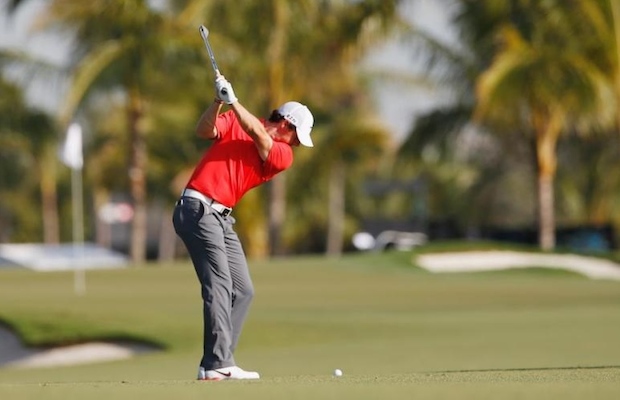
No matter how good your car looks, it only drives as good as the engine in it. Golf is very much the same. No matter how good a swing looks, it’s only as good as the parts that make it up. And the most important part, the engine of the golf swing if you will, is the positioning of the clubface at impact.
“Golf is what the ball does” John Jacobs famously said; and what the ball does is a function of the club face at impact. To get the clubface to impact properly, we need to look at the club face prior to impact. These checkpoints are a way to monitor the position of clubface throughout the swing, and give us an indication of what golfers need to work on to achieve the best possible clubface position at impact for them.
What most golfer don’t realize is how fast their downswing unfolds. It takes less than a second — about 0.80 seconds for an average professional — or three times faster than the backswing. Considering how brief the interval is from the top of the swing down to the ball, there is very little if any time to correct a club face that is not square. Yet that is exactly what millions of golfers are doing. That’s why it’s so important for golfers to put the club in a good position at the top of the backswing, and for top ball strikers, that means having what we call a “square face.”
There are of course some great professionals who do not square the face at the top, but these few exceptions do not negate this principle for the average golfer. So what is “square”?
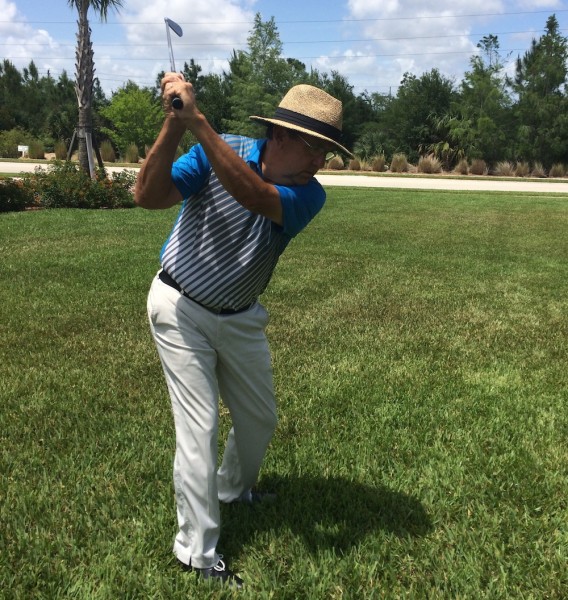
Above: “Square” is the word we use to describe the clubface at the top of the swing that is laying on the plane of the swing.
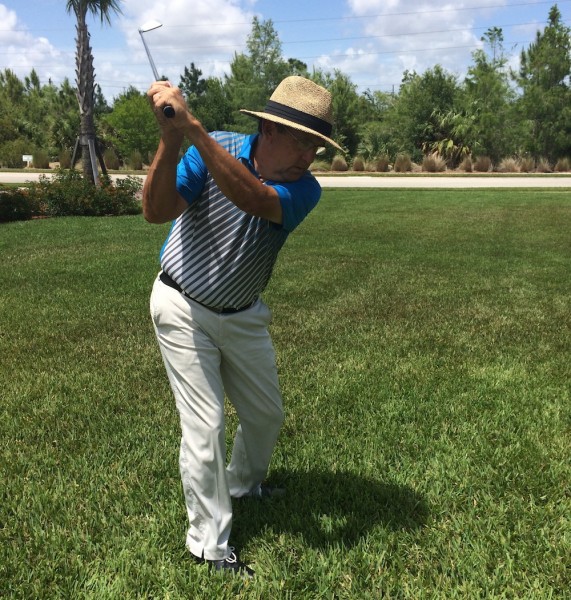
Above: “Closed” is the word we use to describe a clubface at the top that is looking at the sky.
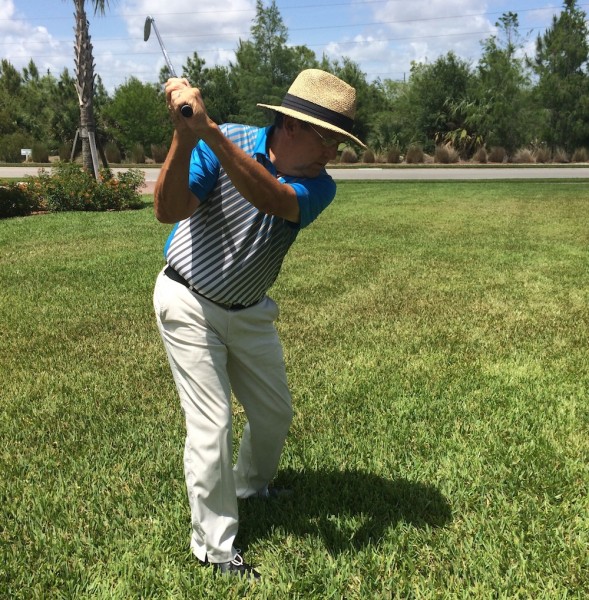
Above: “Open” is the word we use to describe the clubface at the top that is looking more down at the ground.
In actuality, here what those terms mean. The clubface we call “square” is actually 90-degrees open to the target. The club face we call closed is actually square to the target, and the one we call open is even more open, about 180-degrees open to the target.
The reason for this seeming conundrum is this: As golfers take the club back, they actually twist the club face by a simple rotation of the arms as the shoulders turn. They twist it “away” from the square position it was in at address. So if you go to the top of the swing and bring the “square” club face down to the impact position, you will see that it is completely open. In other words, golfers need the same amount of rotation of the arms in the downswing as they had going back. Most golfers do not correct the face coming down, and that lack of proper rotation of the arms in the downswing is one of the most common faults in golf.
One of the ways to correct this might be keeping the club actually square, or closed at the top of the swing. So just what happens if you don’t rotate the arms at all going back? It’s perfectly fine to do this, taking the club back with NO twisting or rolling of the arms. In fact, I strongly suggest it for most people who fight a slice.
Remember, at address the club face is looking at the ball. If you’re having trouble squaring the club face at impact, simply try keep it looking at the ball all the way to the top. This is guaranteed to help those of who leave the face open.
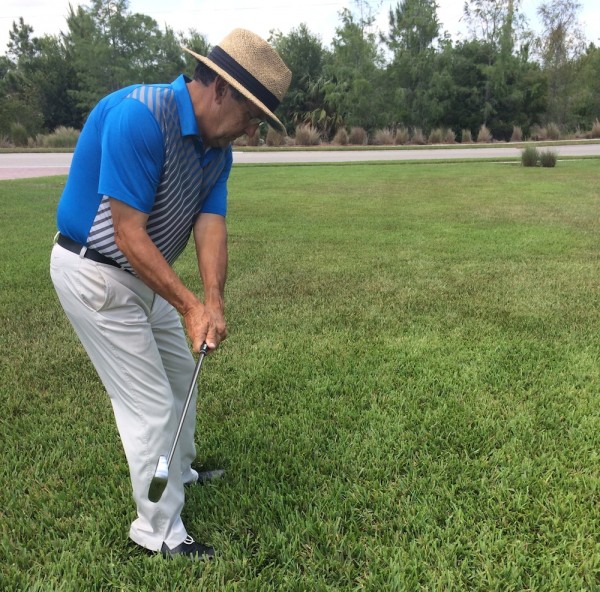
Above: A clubface that is “square” while starting back.
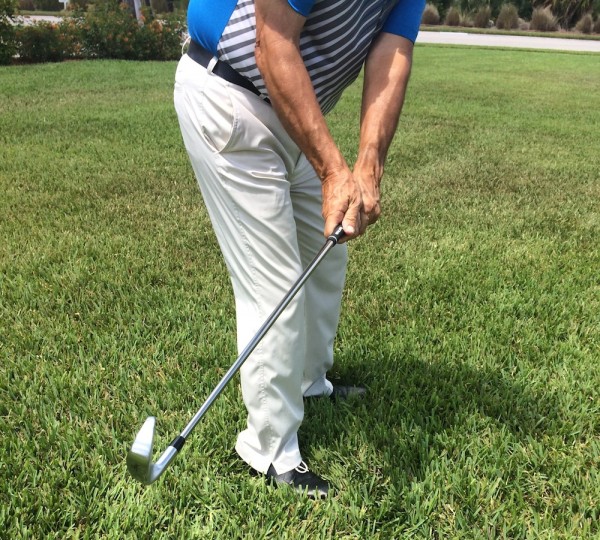
Above: A clubface that is “open” while starting back. Note: This club is only slightly open.
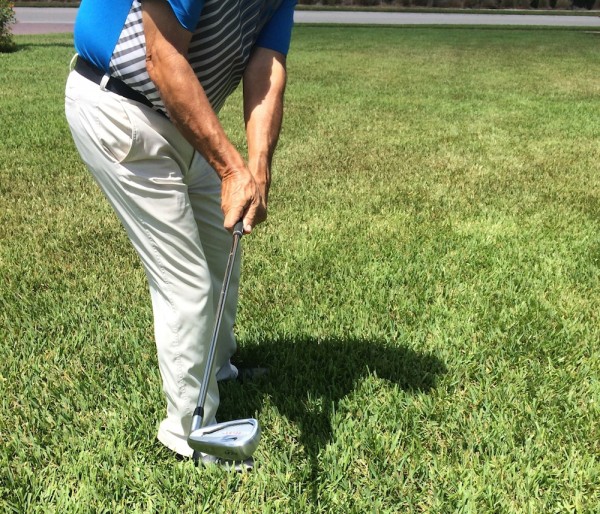
Above: A clubface that is “closed” while starting back.
Now what if you do rotate the arms and roll the face to what we call the “square” position at the top of the swing. Well, again, as the downswing takes such a short time, it is essential to start the squaring the clubface early in the downswing. Like right away.
For those of you who slice. As soon as you begin the swing down, start turning your right palm down to the ground. DO NOT wait until you are entering the impact zone to try to square the face, because it will be TOO LATE. Left alone the club face will remain OPEN. That’s why it’s vital to twist it to a square position.
Here’s a good drill to help you feel release. Put your left hand on the club in a regular grip position, but put your right hand all the way down on the shaft. Now make a few practice swings and feel what your hands are doing. They’re rotating, aren’t they?
You also have to consider the plane of the downswing. Golfers who swing flatter, or more horizontally into impact will find it much easier to twist the club face back to square. Those of you who are swinging too steeply, or vertically on the downswing will find it much more difficult to twist. That’s because when the center of mass of the golf club gets even with or under your hands, the “release” (or what’s called the torque or twist) will happen much more passively. If you hit balls on a side hill lie above your feet, your shots will draw/hook most of the time due to this principle as well as the lie angle of the club. This aspect is what really separates the wheat from the chaff in golf.
Watch the swings of the very best players; they are not struggling to square the face. It simply happens as the result of a good grip and the more horizontal plane of their downswing.
Last, but certainly not least, is the grip. I and many others have written on this subject ad infinitum. But this part of the swing can never be exhausted. Every golfer who is trying to improve needs to find a way to hold the golf club in such a manner that it squares the face for that golfer. I cannot universally prescribe a grip for you, but I will offer this rule of thumb: If you tend to come into the ball steeply, you need a stronger-than-normal grip. If your downswing is flatter, you can hold the club in a more neutral position.
Further reading: Click here to read Dennis’ story, “Make your grip match your swing.”
As always, feel free to send a swing video to my Facebook page and I will do my best to give you my feedback.
- LIKE367
- LEGIT56
- WOW32
- LOL23
- IDHT18
- FLOP22
- OB16
- SHANK63
Instruction
Clement: Laid-off or perfect fade? Across-the-line or perfect draw?

Some call the image on the left laid off, but if you are hitting a fade, this could be a perfect backswing for it! Same for across the line for a draw! Stop racking your brain with perceived mistakes and simply match backswing to shot shape!
- LIKE0
- LEGIT0
- WOW0
- LOL0
- IDHT0
- FLOP0
- OB0
- SHANK0
Instruction
The Wedge Guy: The easiest-to-learn golf basic

My golf learning began with this simple fact – if you don’t have a fundamentally sound hold on the golf club, it is practically impossible for your body to execute a fundamentally sound golf swing. I’m still a big believer that the golf swing is much easier to execute if you begin with the proper hold on the club.
As you might imagine, I come into contact with hundreds of golfers of all skill levels. And it is very rare to see a good player with a bad hold on the golf club. There are some exceptions, for sure, but they are very few and very far between, and they typically have beat so many balls with their poor grip that they’ve found a way to work around it.
The reality of biophysics is that the body moves only in certain ways – and the particulars of the way you hold the golf club can totally prevent a sound swing motion that allows the club to release properly through the impact zone. The wonderful thing is that anyone can learn how to put a fundamentally sound hold on the golf club, and you can practice it anywhere your hands are not otherwise engaged, like watching TV or just sitting and relaxing.
Whether you prefer an overlap, interlock or full-finger (not baseball!) grip on the club, the same fundamentals apply. Here are the major grip faults I see most often, in the order of the frequency:
Mis-aligned hands
By this I mean that the palms of the two hands are not parallel to each other. Too many golfers have a weak left hand and strong right, or vice versa. The easiest way to learn how to hold the club with your palms aligned properly is to grip a plain wooden ruler or yardstick. It forces the hands to align properly and shows you how that feels. If you grip and re-grip a yardstick several times, then grip a club, you’ll see that the learning curve is almost immediate.
The position of the grip in the upper/left hand
I also observe many golfers who have the butt of the grip too far into the heel pad of the upper hand (the left hand for right-handed players). It’s amazing how much easier it is to release the club through the ball if even 1/4-1/2″ of the butt is beyond the left heel pad. Try this yourself to see what I mean. Swing the club freely with just your left hand and notice the difference in its release from when you hold it at the end of the grip, versus gripping down even a half inch.
To help you really understand how this works, go to the range and hit shots with your five-iron gripped down a full inch to make the club the same length as your seven-iron. You will probably see an amazing shot shape difference, and likely not see as much distance loss as you would expect.
Too much lower (right) hand on the club
It seems like almost all golfers of 8-10 handicap or higher have the club too far into the palm of the lower hand, because that feels “good” if you are trying to control the path of the clubhead to the ball. But the golf swing is not an effort to hit at the ball – it is a swing of the club. The proper hold on the club has the grip underneath the pad at the base of the fingers. This will likely feel “weak” to you — like you cannot control the club like that. EXACTLY. You should not be trying to control the club with your lower/master hand.
Gripping too tightly
Nearly all golfers hold the club too tightly, which tenses up the forearms and prevents a proper release of the club through impact. In order for the club to move back and through properly, you must feel that the club is controlled by the last three fingers of the upper hand, and the middle two fingers of the lower hand. If you engage your thumbs and forefingers in “holding” the club, the result will almost always be a grip that is too tight. Try this for yourself. Hold the club in your upper hand only, and squeeze firmly with just the last three fingers, with the forefinger and thumb off the club entirely. You have good control, but your forearms are not tense. Then begin to squeeze down with your thumb and forefinger and observe the tensing of the entire forearm. This is the way we are made, so the key to preventing tenseness in the arms is to hold the club very lightly with the “pinchers” — the thumbs and forefingers.
So, those are what I believe are the four fundamentals of a good grip. Anyone can learn them in their home or office very quickly. There is no easier way to improve your ball striking consistency and add distance than giving more attention to the way you hold the golf club.
More from the Wedge Guy
- The Wedge Guy: Golf mastery begins with your wedge game
- The Wedge Guy: Why golf is 20 times harder than brain surgery
- The Wedge Guy: Musings on the golf ball rollback
- LIKE86
- LEGIT13
- WOW6
- LOL1
- IDHT0
- FLOP4
- OB1
- SHANK8
Instruction
Clement: Stop ripping off your swing with this drill!

Not the dreaded headcover under the armpit drill! As if your body is defective and can’t function by itself! Have you seen how incredible the human machine is with all the incredible feats of agility all kinds of athletes are accomplishing? You think your body is so defective (the good Lord is laughing his head off at you) that it needs a headcover tucked under the armpit so you can swing like T-Rex?
- LIKE0
- LEGIT2
- WOW2
- LOL0
- IDHT0
- FLOP0
- OB0
- SHANK2
-

 19th Hole2 weeks ago
19th Hole2 weeks agoDave Portnoy places monstrous outright bet for the 2024 Masters
-

 19th Hole2 weeks ago
19th Hole2 weeks agoTiger Woods arrives at 2024 Masters equipped with a putter that may surprise you
-

 19th Hole2 days ago
19th Hole2 days agoJustin Thomas on the equipment choice of Scottie Scheffler that he thinks is ‘weird’
-

 19th Hole2 days ago
19th Hole2 days ago‘Absolutely crazy’ – Major champ lays into Patrick Cantlay over his decision on final hole of RBC Heritage
-

 19th Hole3 weeks ago
19th Hole3 weeks agoReport: Tiger Woods has ‘eliminated sex’ in preparation for the 2024 Masters
-

 19th Hole1 week ago
19th Hole1 week agoTwo star names reportedly blanked Jon Rahm all week at the Masters
-

 19th Hole1 week ago
19th Hole1 week agoReport: LIV Golf identifies latest star name they hope to sign to breakaway tour
-

 19th Hole1 week ago
19th Hole1 week agoNeal Shipley presser ends in awkward fashion after reporter claims Tiger handed him note on 8th fairway















Jon Blazewicz
Jun 24, 2017 at 1:19 am
i’m toying with the idea of taking my swing to the top and adjusting it square up there in the air so to speak. When i bring it back it is very slightly open and feels weird, but the downswing feels good and strong and the release feels good
Jeff Chuh
Apr 27, 2017 at 8:34 am
As the article suggest, when I try to put right palm face to ground, the club face indeed square at impact yet it may cause me to casting…
Jeff*
Jan 12, 2016 at 3:30 pm
Love your articles. Especially in the winter, I feel more prepared for next season, thanks.
Bob
Nov 19, 2015 at 7:41 am
Isn’t the main problem with slicing not turning your core early enough and losing balance backwards towards the end of the swing?
Richard Grime
Nov 6, 2015 at 3:49 pm
Yup, this makes perfect sense. The better players flatten the downswing and have less issues with slicing.
Tiger Tiger Woods y'all
May 12, 2014 at 10:31 am
V
Tiger Tiger Woods y'all
May 12, 2014 at 10:37 am
I spent years trying to make a strong left hand grip work ,because that what everyone said would stop slicing and weak fades and help square me at impact. I finally recently went to a very weak left hand and it’s like heaven. With good tempo the face just naturally squares at impact. You must work hard and find a grip that just naturally hits square. Making adjustments to the face during the swing is killer, causes flipping.
DaveMac
May 9, 2014 at 6:06 pm
Just to say the total swing time is about 1 second and downswing is about 0.33 seconds (0.75 and 0.25 for quicker tempo player professional and amateur).
Dennis Clark
May 2, 2014 at 1:15 pm
An added note from the author: The closed club face CAN have a steepening effect on the swing, that is make it more up and down> So it can be doubly effective for those open and a bit flat.